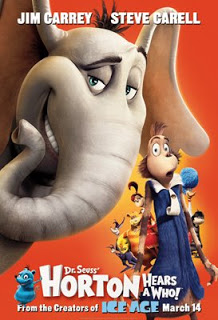 “Horton Hears a Who” stampeded into theaters March 14th. Dennis Leonard supervised the Dr. Seuss adaptation. Randy Thom served as sound designer and re-recording mixer. Mixing took place at Thom’s usual stomping ground, Skywalker Sound. Along with Gary Rizzo, the two mixers helped populate whoville with sound for Horton to hear. Original dialog recording for “Horton” was handled by Carlos Sotolongo whose work will be heard in another animated film this summer, June’s “Kung Fu Panda”. Score for “Horton” was tracked at the Newman Scoring Stage at Fox. John Powell who is currently on this July’s “Hancock” composed for the film. Below is an interview excerpt from Ain’t It Cool News featuring Powell in 2006 talking about a particular “Horton” sequence. Below that is Randy Thom expanding on the work he and Powell did in that sequence for Film Sound Daily.
“Horton Hears a Who” stampeded into theaters March 14th. Dennis Leonard supervised the Dr. Seuss adaptation. Randy Thom served as sound designer and re-recording mixer. Mixing took place at Thom’s usual stomping ground, Skywalker Sound. Along with Gary Rizzo, the two mixers helped populate whoville with sound for Horton to hear. Original dialog recording for “Horton” was handled by Carlos Sotolongo whose work will be heard in another animated film this summer, June’s “Kung Fu Panda”. Score for “Horton” was tracked at the Newman Scoring Stage at Fox. John Powell who is currently on this July’s “Hancock” composed for the film. Below is an interview excerpt from Ain’t It Cool News featuring Powell in 2006 talking about a particular “Horton” sequence. Below that is Randy Thom expanding on the work he and Powell did in that sequence for Film Sound Daily.
SK: Will you be working on anything until then?
John Powell: Yes. I’ll be doing pre-work on “HORTON HEARS A WHO” (2008) for Blue Sky and Fox and that doesn’t come out until March of 2008. I’m basically just writing some pieces of music that we need right now. If you look at the book, as with a lot of Dr. Suess books, they’re very musical in the sense that they have a lot of people playing crazy instruments. In this one, the huge climax there’s this whole society trying to make itself heard and they’re playing every conceivable kind of instrument you’ve ever seen…or not seen actually. That has to be done in advance. We can’t just start animating to nothing…it has to sound like something.
…and now Randy Thom describes his experience.
“Horton Hears A Who” was a blast to work on. Jimmy Hayward and Steve Martino, the Directors, are very sound-conscious guys who are always interested in experimenting, and John Powell, the Composer, and I had a great collaboration. This was one of those rare films where the sound effects and music for a sequence were orchestrated to work seamlessly together. One of the characters in the movie constructs a giant music making machine in an abandoned observatory. It’s a Rube Goldberg kind of contraption with gears, bows on saws, huge rubber balls pounding on trampolines, etc., that we wanted to sound like a kind of industrial symphony orchestra. John recorded lots of exotic musical instruments for the sequence, and we did the same on the sound effects side. Then the challenge was to cut all these sounds together so that the music and sound effects and music complimented each other. Pete Horner traveled down to Los Angeles from our home base at Skywalker, and he worked with the music editors to weed out the many, many elements we had recorded and gathered for the “machine” part of the sequence. Colette Dahanne did a lot of editing on that sequence too. By the way, there was score running through this scene in addition to the “source” symphonophone. When we begin a project we often try to coordinate sound effects and
music in this way, and I’m proud to say that this time everything came together that allowed it to happen. We’ll definitely be doing more of this kind of collaboration in the future.
UPDATE: something I missed (thanks GUYS). Randy chatted with some folks about a sound designer’s role in film and among others why we don’t mix on headphones, HERE.